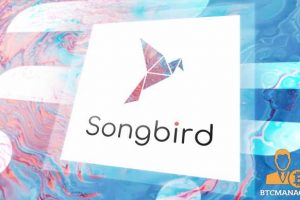Flare’s Canary Network Songbird Successfully Passes Observation Stage

Songbird, the canary network of Flare Networks has successfully exited the observation stage.
Flare’s Canary Network Exits Observation Stage
In an announcement made today, Flare Networks – a scalable, low cost, low carbon, and decentralized smart contract platform leveraging the Ethereum Virtual Machine (EVM) and based on the Federated Byzantine Agreement-based consensus announced its canary network Songbird had exited the observation stage.
This marks an important step forward in Flare Network’s long-term goal of enabling Turing-complete smart contracts for all native blockchains without smart contract functionality.
Notably, Songbird has launched and successfully exited the 10-day long observation mode which is the first of the three preset phases it must go through to become battle-tested and hardened for the eventual launch of the Flare Networks.
Songbird’s observation mode was launched on September 16 and successfully concluded on September 27 at 14:00 GMT. You can learn more about this phase here.
The Significance of Observation Mode
The first of the three phases to ensure network health and efficiency, the “Observation Mode” played a significant role to deploy and test the underlying network and the Flare Time Series Oracle (FTSO).
For the uninitiated, the FTSO is the first of the 3 protocols that bring together almost 65% of the value in the crypto industry to be used trustlessly on the Flare Networks with highly scalable EVM-based smart contracts.
The remaining two protocols, namely the State-connector and the F-asset contracts will subsequently be deployed on the canary network (Songbird) for intensive testing before the Flare Networks is launched.
The aforementioned combined protocols will enable the tokens without any native smart contracts (and the ones that do) to enjoy direct accessibility and scalability on Flare in decentralized applications (dApps) including fast and complex payments mechanisms, metaverses, NFTs, DeFi, and gaming.
It is worthy of note that the deployment of the network and FTSO passed the observation mode with encountering any unanticipated issues. More than 340 validators and over 40 data providers have already applied for whitelisting on the network – a figure that rivals that of Polkadot when it launched its own canary network Kusama.
Songbird draws inspiration from Kusama in that it also aims to be a combination of an advanced testing network and eventually establish itself as the hotbed for testing governance-based updates to the Flare network.
Further, Songbird can also potentially carve out its own path at the behest of its token holders. That being said, the FTSO will continue to be battle-tested with real value at stake while at the same time, the Songbird network will go ahead with its launch process and remove any whitelisting requirements.
To date, a wide range of DeFi projects, data providers, exchanges, wallets, and custodians, have expressed their support and plan to launch and test their applications on Songbird. These include Gala Games, 888 TNW, Trustline, Global Esports Federation, Delchain, Lena Instruments, Flare Finance, Ola Finance, and Flare Metrics among others.
It’s worth mentioning that between the State-connector and the FTSO, there is a 10% built-in first-year inflation which would eventually reduce in subsequent years. As much as 80% of the total yearly inflation is distributed to users who delegate to the FTSO system.
Commenting on the development, Hugo Phillion, Co-founder of Flare Network, said:
“Songbird marks a key step for the entire industry in enabling tokens on networks without smart contracts to be used trustlessly and in a non-custodial manner for the first time with scalable smart contracts. Over the last week witnessing the Flare community start to interact with the Songbird and particularly the FTSO has been wonderful for myself and the team to observe. So far only one of the core protocols put forward by Flare is operating on Songbird.”
Adding:
“We are particularly excited to take part in the testing on Songbird of the remaining protocols leading, once tested, to the full launch of The Flare Network. We are very thankful to the community for their support, excitement and participation in Songbird and the protocols that Flare is bringing to the industry. I’d like to take this opportunity to remind the community that a canary network is a mainnet designed for live testing and experimentation. It is possible that some level of disruption & potential risk of funds could occur.”
What’s Next?
Now that Songbird has exited the observation mode, its next phase of testing will include the deployment of the State-connector that allows state from virtually any blockchain to be used by any smart contract on Songbird, and eventually, Flare.
Once the State-connector has been tested effectively, Songbird will then eventually enter the unrestricted phase, which would mean that the consensus is handed over entirely to external validators. Later, the future trajectory and path of Songbird will be determined by its own governance and the rapidly growing community of SGB token holders.
To learn more about the development, check out the Flare Networks blog here.
Related posts:
Source: Read Full Article
